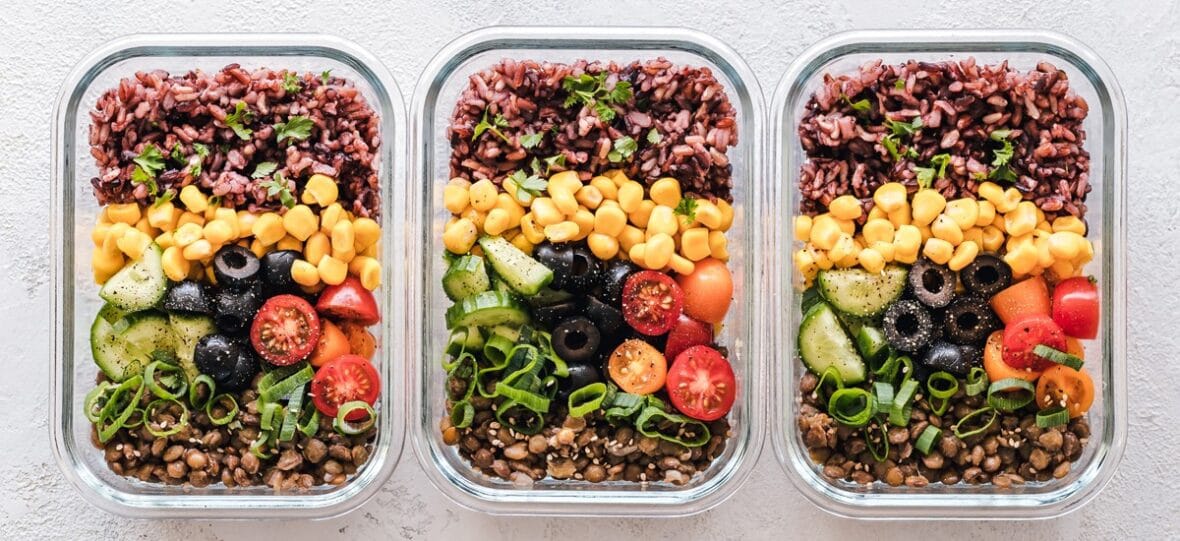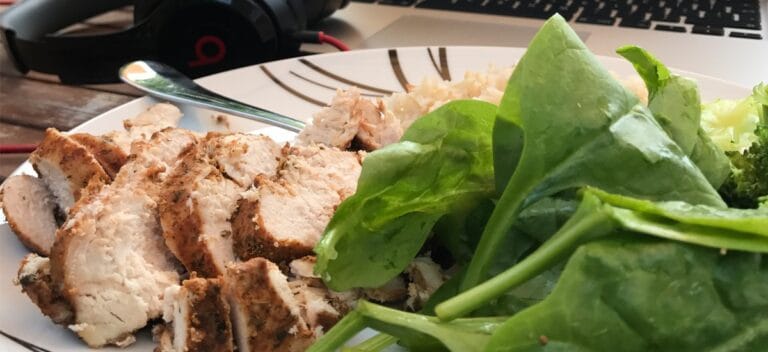Meal preparation can help you achieve your nutrition goals, whether it’s to lose weight, fat, build muscle or to generally improve your overall diet. In this guide, we will look at what meal preparation is, how you can implement it around your lifestyle and of the benefits that can come with it.
Topics covered in this guide:
- What Is Meal Prep?
- How To Meal Prep?
- Meal Prep Benefits
What Is Meal Prep
Meal preparation is simply preparing multiple meals in advance so you avoid having to cook 3-5 times a day. It may sound a bit daunting at first due to the thought of having to cook and store so much food, but really it’s a lot simpler than that and we will run through the best processes for this as we go through this guide.
Meal prep will allow you to hit your daily nutritional target and not skipping any meals. For example, if you are looking to lose weight, you may need to eat around 1,500-2000 calories in total throughout the day, which means eating 3 or 4 meals at 500 calories each. Having your meals split out like this means you know that you are going to hit your calorie goals, as well as cutting the risk of not getting the right nutrition.
How To Meal Prep
There are a number of different ways you can approach meal preparation. Of course, not one plan works for all, but the general concept behind it is the same. You will want to buy your food in bulk, cook it all and store your future meals for later. This means you can start the next day with your planned meals ready to eat, whether it’s your breakfast, lunch or dinner. You can just serve your meal straight up which will be quicker than cooking from scratch, thereby saving you time.
There are a few things you should consider before you start to meal prep – we will cover the general challenges below:
1. Focus On Your Lifestyle
One of the most important areas to look into is your lifestyle. You can try a range of different plans, but it’s no good if they don’t fit your individual needs.
You need to be realistic and set goals which are achievable. For example, it could be something as simple as deciding when to get your food. It could be after work when on the way home, maybe at the weekend, or planned around family commitments. The point here is to think about making the process as convenient as possible for you.
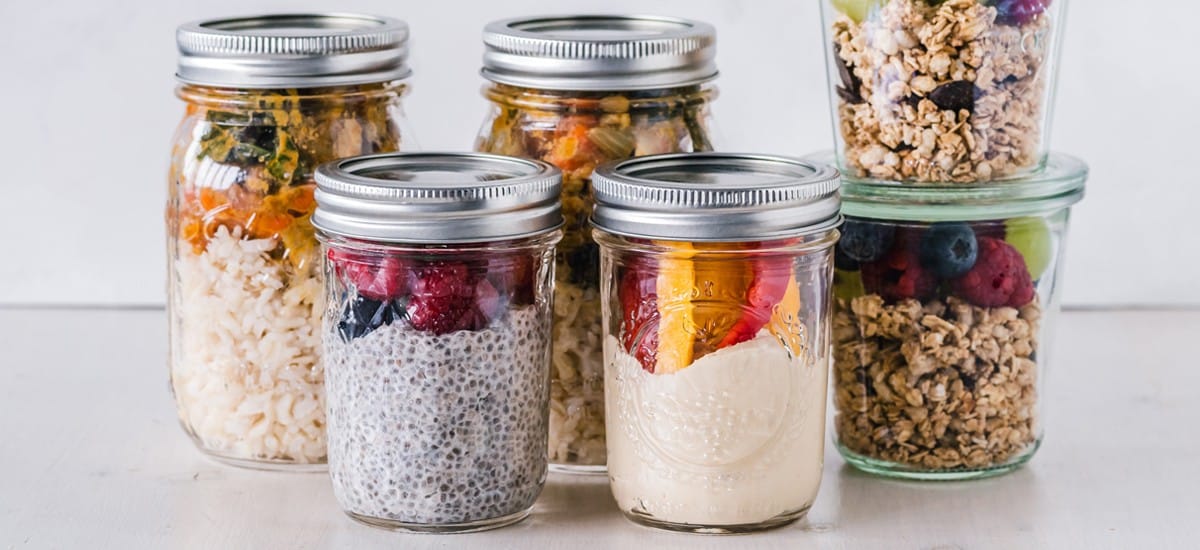 Image Credit: Ella Olsson | Pexels
Image Credit: Ella Olsson | Pexels
2. How Much Food To Cook?
It’s easy to think you should cook as much as possible and to store it away for later use. This is generally the right idea but you can overdo it and face problems such as the food going out of date, or taking up to much fridge space.
We would recommend you start off by cooking a small amount and seeing how this goes for 1-2 days. If this works well, then consider cooking more food and allocating more space.
Here’s a few example methods of the meal prep processes:
Daily Meals Prep
- Prepare your meals in full and have them ready to go for the next day.
- You should consider your approach to your meals based on what’s convenient for you to take on the go.
- For example, the food you prepare can be taken in a lunch box and eaten hot or cold depending on any facilities available.
Mass Meal Prep
- Prepare your meals in bulk and store in the freezer.
- For example, a standard meal could consist of chicken, rice and veg.
- The idea here is to cook multiple meals and then use what you need when you need it. This means you could potentially look at planning ahead for 3-5 days.
Ingredients preparation
- Here you simply pre-prepare your ingredients and store them away.
- This will save you time as the preparation work will already be complete.
- For example, with an onion, you can save time on the peeling and dicing.
You can mix up these processes or even find other ways which work for you. The key here is to look at your lifestyle, your access to foods, your dietary needs and portion sizes (do you have a family etc). Once you consider all the factors and put in some practice you will find that there are ways which can help you save time and also eat healthier choices.
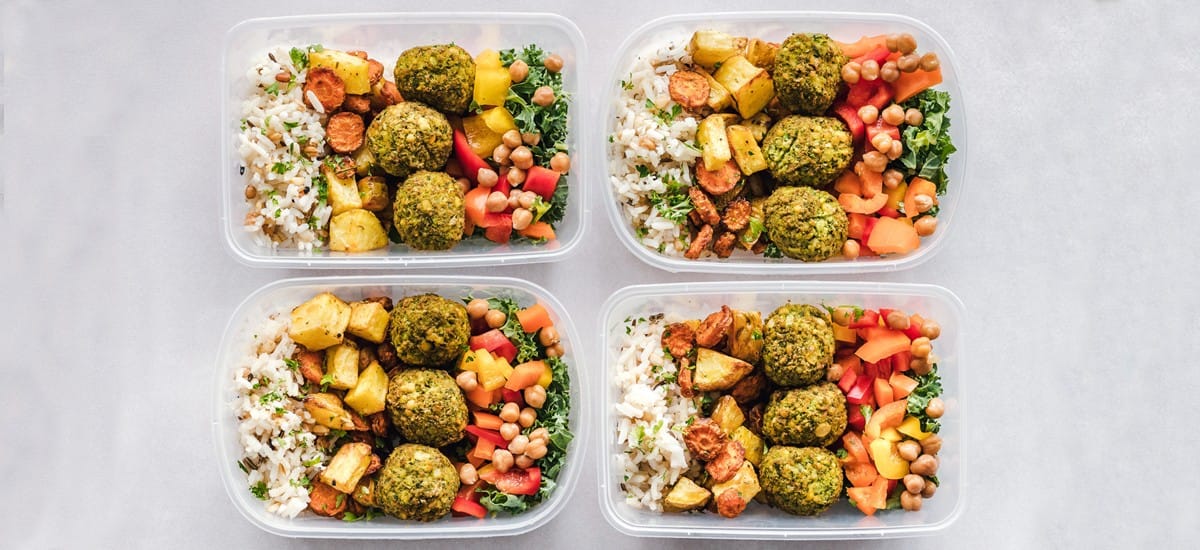
3. How To Keep Motivated
Meal preparation can be an exciting process at first as it can help you to eat healthily and save you time and effort. However, it can be easy to lose motivation with the main cause being a lack of variety in your food.
Nobody wants to have the same meal 4 times a day 7 days a week. This is why it’s important to make sure to add different foods to your diet. Not only will this stop you from getting bored but it will also help you to get more varied vitamins and minerals from all the different food sources.
You may also get caught up in long cooking hours, even though it may only be once or twice a week, and this can put you off track. To counter this you should allocate a dedicated amount of time and stick to it. Plan ahead and always have a plan B in case something unexpected turns up.
4. How To Store Food
Key considerations when it comes to meal preparation are where and how you will store your food. You need to consider how long you want your food stored for, for example, for food prepared for 1-3 days store in the refrigerator. For any longer period, it should be frozen.
You also need to consider the containers you are using to store your food. Tupperware and glass containers are ideal for fridge food as they are easily sealed and suitable for the microwave.
Plastic lunch boxes are convenient if you are looking to take 1 or 2 meals with you to work. Make sure the plastic containers you use are the correct type of plastic for storing or microwaving food. You can research more about this online, you want to look for BPA- free microwavable containers as they are better for your health.
If storing in the freezer there are 2 key steps you should generally follow:
- Let the food cool down to room temperature before you freeze.
- When defrosting, take the container out of the freezer and place in the fridge the night before.
It’s not recommended to microwave your food directly from frozen as this can ruin the food and also pose health risks – Please check the NHS advice for further information.
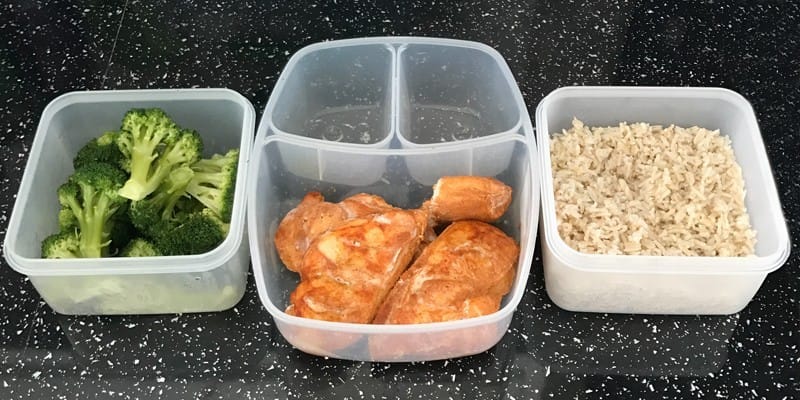
The Benefits Of Meal Preparation
We will now look at the benefits that come from meal preparation and how these can help support your own nutrition goals and positively impact your lifestyle.
Save Time
The amount of time you can save by meal prepping is life-changing. It’s so much easier to achieve your fitness goals when you know what nutrition and the amount you’re consuming ahead of time. Cooking in bulk means you prepare in one big session rather than multiple times a day, thus saving time. This is a great process for anyone who has limited time during the day due to a busy working lifestyle.
Easier To Eat Healthy
It can be easy to just eat what you feel like when you feel like it, especially if you’ve had a busy day or week. This can lead to challenges when trying to achieve your nutritional goals. With meal prep, you can always stay ahead of this temptation by making sure you’re preparing healthy meals in advance which are readily available.
Saves Money
You will find that there’s plenty of opportunities to save money by meal prepping. This is because food ordered in bulk generally works out cheaper than buying in single items. For example, if you look at supermarket labels you can sometimes see the cost per unit or KG/Litre. Generally the higher the total volume the cheaper the unit cost.
Another way costs can be saved is by avoiding random prices on takeaways or fancy meals. For example, on average you can spend anywhere from £8 – £20 on a takeaway and this is just for one meal.
Improves Consistency
Consistency is key for mastering a nutrition plan which produces results. The beauty of meal prep is that it is consistent and keeps you on track with hitting your macros. Macronutrients are basically getting the right balance of fats, proteins and carbohydrates to achieve the desired result such as weight loss or muscle gain.
Summary
Give yourself some time to trial and error and see what works best for you. If your current approach doesn’t work, adapt and try something different. Remember it’s not about following any single plan, but instead looking at your current lifestyle and changing to suit your needs.
Next Section – Healthy Lunches
Our next section focuses on the importance of lunchtime meals and how you can create a solid routine.

